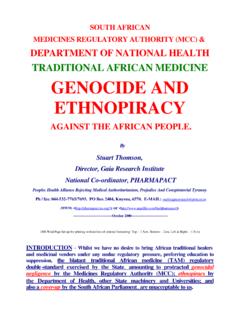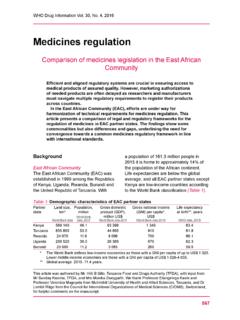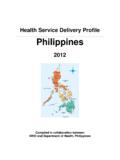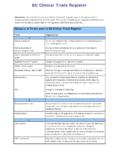Transcription of chapter 6 Pharmaceutical legislation and regulation - WHO
1 chapter 6 Pharmaceutical legislation and regulationSummary The role of Pharmaceutical legislation and regulation Pharmaceutical laws and regulations are necessary Differences between Pharmaceutical laws, regulations , and guidelines Evolution of policy and law Globalization and harmonization Drafting and revising Pharmaceutical legislation and Basic elements of national Pharmaceutical legislation Key provisions of national Pharmaceutical legislation the roles of various parties Licensing, inspection, and quality control Pharmacovigilance Advertising and promotion Medicine registration, licensing, and marketing authorization pharmaceuticals for dispensing Regulating traditional and herbal Controlling alternative and informal distribution channels Substandard and counterfeit medicines Establishing effective administrative control resources Financing Guiding principles for small national drug regulatory Evaluating the effectiveness of Pharmaceutical legislation and further readings guide 6-1 Resources for medicine registration in twenty-six African countries 6-2 Reports of counterfeit medicines by therapeutic class received in 2007 6-1 Resources required for effective administrative control studiesCS 6-1 The evolution of Pharmaceutical legislation 6-2 Harmonization efforts in the Americas 6-3 Revising registration procedures in Namibia 6-4 Regulatory interventions in Lao
2 6-1 Elements of a comprehensive drug law 6-2 Adverse drug reaction monitoring 6-3 Stages in the evolution of a medicine registration system 6-4 Interchangeability 6-5 Regulatory hurdles in the development of microbicides for HIV/AIDS I: Policy and economic issuesPart II: Pharmaceutical managementPart III: Management support systemsPolicy and legal framework 1 Toward sustainable access to medicines 2 Historical and institutional perspectives 3 Intellectual property and access to medicines 4 National medicine policy 5 Traditional and complementary medicine policy 6 Pharmaceutical legislation and regulation 7 Pharmaceutical production policy 8 Pharmaceutical supply strategiesFinancing and sustainabilitycopyright management sciences for health PoLICy AND LEgAL The role of Pharmaceutical legislation and regulationThe role of pharmaceuticals has become more prominent on international agendas as health indicators have been increasingly linked with a country s successful development.
3 In addition, the legal and economic issues that surround pharmaceuticals have become more complex and politi-cized because of the increase in global Pharmaceutical laws and regulations are necessaryThe use of ineffective, poor-quality, or harmful medicines can result in therapeutic failure, exacerbation of disease, resistance to medicines, and sometimes death. It also under-mines confidence in health systems, health professionals, Pharmaceutical manufacturers, and distributors. To protect public health, governments need to approve comprehensive laws and regulations and to establish effective national regu-latory authorities to ensure that the manufacture, trade, and use of medicines are regulated appropriately and that the public has access to accurate information on between Pharmaceutical laws, regulations , and guidelinesLaws today are usually written in fairly general terms to meet present and possibly future needs.
4 Laws usually have language that enables the government to issue regulations based on the law. Passing new laws may require a lengthy process, with the country s legislative branch giving final approval. regulations can be passed more rapidly and sim-ply than laws, sometimes requiring, for example, only the approval of a single government minister on the advice of experts. They can also be altered more easily. After approval, a regulation has the same power as the law itself. guidelines, which do not carry the force of law, can be more easily modi-fied and updated and offer informal information on what the government s thinking is regarding the best way to implement regulations . Following guidelines will help avoid misinterpretation of and facilitate compliance with laws and involve many parties, including patients, doctors, other health workers, salespeople, and manufactur-ers. The field also involves important risks: people can suf-fer or die not only from a lack of medicines, but also from drugs that are impure, wrongly prescribed, or used incor-rectly.
5 Thus, it is easy to see why laws and regulations are needed. However, some argue that medicines like many other commodities should be subject only to the control of the ultimate user. But medicines are indeed different, as discussed in chapter , informal controls are insufficient: charla-tanism or quackery (that is, the deliberate sale of remedies known to be worthless) is centuries old, and firm action may be needed to put a stop to it; however, as discussed later in the chapter , the Internet presents new challenges in Realistic and effective laws and regulations are needed for the Pharmaceutical sector because Pharmaceuticals concern the whole population Many parties are involved: patients, health provid-ers, manufacturers, and salespeople Serious consequences, including injury and death, can result from the lack or misuse of medications The consumer has no way to determine product quality Informal controls are insufficientCountries may choose to develop new legislation or to revise existing laws.
6 When starting afresh, it is useful to prepare a general law. Models exist, and expert assistance is readily available. After the law is passed, regulations made under it can bring its various provisions into oper-ation, one by one, as the necessary resources and experi-ence are drafting or revising legislation , a country should Inventory the laws and regulations already in force Determine what type of legislative instrument is required Involve both legal and health experts Keep all interested parties informedNational drug legislation generally includes provisions relating to the manufacturing, importing, distribution, marketing, prescribing, labeling (including language), dispensing, and sometimes pricing of Pharmaceutical products, as well as the licensing, inspection, and control of personnel and facilities. A regulatory authority is usu-ally established for administrative control. Medicine registration is often a major element in legislation , to ensure that individual products meet the criteria of effi-cacy, safety, and that need to introduce comprehensive legisla-tion can seek guidance from the experiences of others and from wHo (2001a) 6 / Pharmaceutical legislation and regulation deceitful drug promotion.
7 Counterfeiting, also, has been on the rise in developed and developing countries. customs officials, for example, report that pharmaceu-ticals are one of the fastest-growing categories of counterfeit goods coming into the country illegally. Pharmaceuticals accounted for 10 percent of total seizures in 2008 to become the third-largest category, compared to 6 percent in 2007 (Mui 2009).The approach to Pharmaceutical regulation should not be simply punitive: rules creating a positive situation tend to be more effective. Finally, laws and regulations are effective only to the extent that they meet society s of policy and lawThere may be a long preparatory period before the sort of consensus develops that can form the basis for a law. It is sometimes preferable to work for a while with informal agreements among parties or with government guidelines, so that generally accepted rules of behavior can develop in practice; the law then serves to confirm and formalize them (see Country Study 6-1).
8 Whether or not a national drug policy exists, countries need effective, enforceable legislation and regulation . These legislative acts may take the form of a single national drug law that deals with all the issues or a series of complemen-tary laws, each introduced when the time is right. In some countries, certain aspects of the Pharmaceutical sector are governed by national laws, and other aspects, such as phar-macy and medical practice, are governed by state or provin-cial laws. This chapter focuses on a single, comprehensive drug law at the national level. Most of the issues discussed are also applicable in situations where legal responsibility is divided between national and state or provincial law on medicines must, first and foremost, clearly define what all the parties manufacturers, doctors, pharmacists are required to do, so that no serious mis-understanding is possible.
9 Medicine registration laws and regulations , for example, make clear what a manufacturer needs to do to obtain a license to sell a product. They define how a registration agency should assess both the manufac-turer and the product to determine if they meet society s good law also creates administrative bodies to put rules into practice for example, a national drug regulatory authority with broad competence, or separate organs to deal with the various aspects of Pharmaceutical regulation such as practice of pharmacy, inspection of factories, and adver-tising of to achieve too much, too quickly, can be tempting. It took more than a hundred years for Pharmaceutical poli-cies and laws to evolve to current levels in the industrialized world. Sensible questions to ask are what are the most important goals to achieve within five, ten, and fifteen years? what means are available to achieve them?
10 In which order can they best be tackled? what help is available?The answers to these questions provide a good starting point in developing both policies and the laws needed to support and regulations are intended to be used together to achieve their objective. It is appropriate to begin with passing a broad law, emphasizing the requirement that pharmaceu-tical products be safe and effective. The various provisions of the law are then brought into operation through regula-tion, step by step, addressing the most important things first. For instance, in resource-constrained countries, setting up a new Pharmaceutical distribution system may be urgently necessary, but Pharmaceutical registration can wait for sev-eral years, while procuring essential medicines in the mean-time through reputable channels where product quality is and harmonizationLaws and regulations evolve within countries over time, but in recent years, the trend has been toward the globalization of Pharmaceutical issues, which affects national legislation .
















